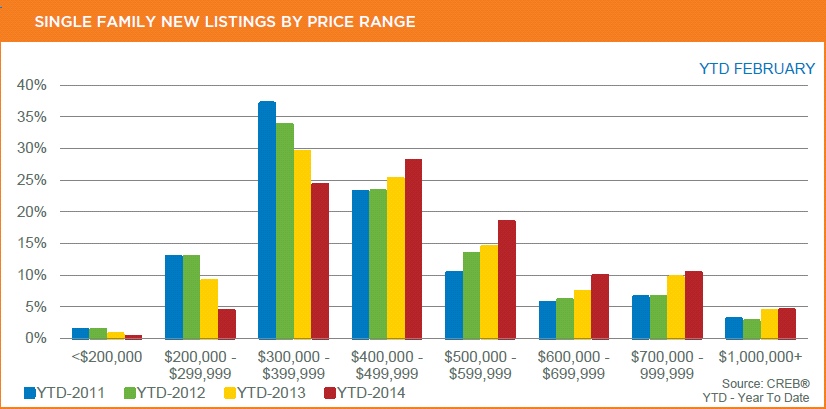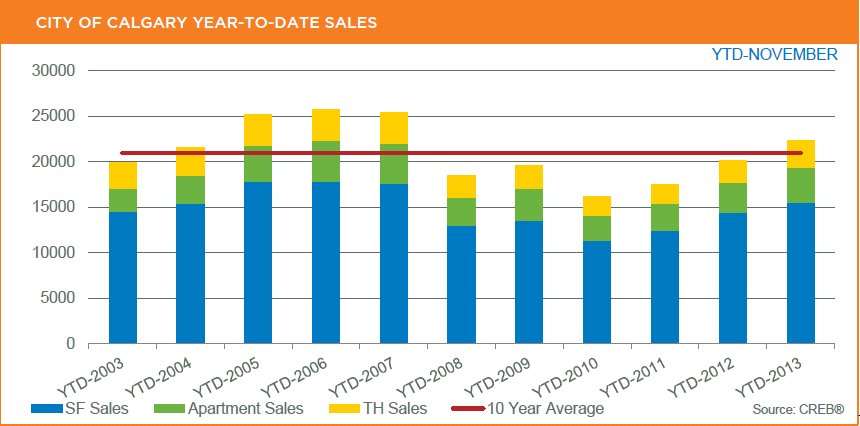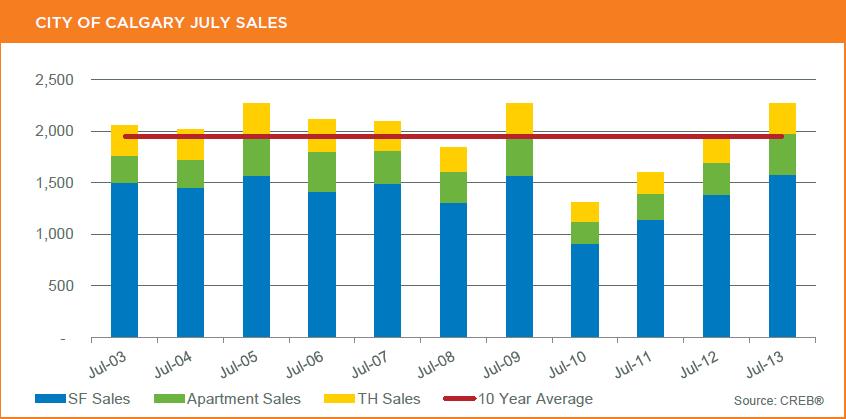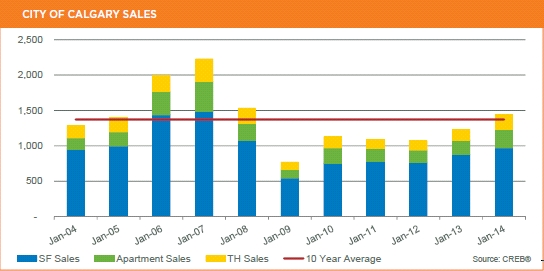Sales growth boosted by condominium activity
Lack of choice in single family sector impacts sale growth.

Click on the following link or on the photo above to view the .pdf of The CALGARY REGIONAL HOUSING MARKET STATISTICS for February 2014.
Following double digit gains last month, sales growth in the city of Calgary totaled 1,854 units, or an 8.68 per cent increase over the same period in 2013. Slower sales growth resulted in a reduction of listings in the single family sector. However, single family sales still totalled 1,230 units, a 1.9 per cent increase over the previous year.
“Demand growth in the single family sector has been restricted by the availability of product,” says CREB® Chief Economist Ann-Marie Lurie. “New listings in this sector fell for the second consecutive month, causing further tightening in an already undersupplied market.”
Despite the pull back in the single family sector, condominium sales continue to surge. After the first two months of the year, both condominium apartment and townhouse sales increased by 28 per cent compared to last year.
“Consumers who are in the market for single family homes priced below $300,000 do not have many options, and when product does become available, it typically does not stay on the market for long,” says CREB® President Bill Kirk. “However, nearly 54 per cent of the new condominium apartment listings this year are priced below $300,000, which is providing options for consumers looking for affordable product.”
The condominium market benefited from significant gains in new listings. Year-to-date, condominium apartment and townhouse listings improved by a respective 17 and 4 per cent for a combined total of 1,737 units.
“As we move into the spring market we expect that listings will improve in all sectors,” says Kirk. “The rise in listings will help ease some of the tightness in the market, with price growth impacts varying by community and property type.”
With no significant additions to the housing supply, resale prices continued to rise.
The unadjusted single family benchmark price totalled $482,800 in February, a 1.28 per cent increase over the previous month and a 9.1 per cent increase over the previous year.
Meanwhile, condominium apartment and townhouse prices totaled a respective $283,400 and $309,700. Condominium apartment price increases remain at double digit levels this month with a year-over-year gain of 12.4 per cent.
Despite the strong gains in condominium prices, overall benchmark prices in both the apartment and townhouse sector continue to remain below peak records set back in 2007.
“Resale market conditions have favoured the seller, and this has translated into price gains, which is strongest in the condominium sector,” says Lurie. “However, it is important to note that condominium prices have not yet risen above previous highs, whereas single family prices recovered last year.”
market report
POSITIVE START TO THE NEW YEAR…
Sales activity and prices improve over 2013.
CALGARY REGIONAL HOUSING MARKET STATISTICS for January 2014
On the heels of a strong year of sales growth, January sales in the city of Calgary totaled 1,440 units, a 17 per cent increase over the previous year.
“Sales growth continues at the double digit pace seen over the later portion of 2013, mostly due to the gains in the condominium sector,” said CREB® chief economist Ann-Marie Lurie. “While these are the highest January sales levels since 2008, total sales transactions are in line with long-term trends.”
Condominium apartment and townhouse sales totaled 466 units in January, a 33 per cent increase over the same period in 2013. This is relative to the 974 sales in the single family sector, only a 11 per cent increase over the previous year.
“Consumers looking for more affordable product turned to Calgary’s condominium market, which was the only sector to record growth in new listings, compared to January 2013,” explained CREB® president Bill Kirk. “The improvement in listings helped ease some of the tightness in the condominium market, however overall conditions continue to favour the seller.”
New listings in the condominium apartment and townhouse market totaled 809 units, a combined increase of six percent. Meanwhile, the single family sector lost momentum significant change in the supply situation this month, prices continue to rise at higher than expected levels.”
To read the full article click on the following link: CALGARY REGIONAL HOUSING MARKET STATISTICS for January 2014
REAL ESTATE QUARTERLY STATISTICS…
Check out the number of resale homes sold and average sale price by district: REAL ESTATE QUARTERLY STATISTICS

CREB®'s 2014 economic outlook and housing forecast.
Chief economist Ann-Marie Lurie speaks to the highlights of CREB®’s 2014 economic outlook and housing forecast. Watch the video by clicking below or Click Here to download the full pdf of the 2014 CREB Forecast Report.

Continuing employment growth and two consecutive years of high net migration levels will underpin a 3.6 per cent growth in resale home sales in Calgary this year, with prices increasing by 4.3 per cent.
“In 2014, both sales activity and prices are expected to improve, but not at the same pace recorded in 2013,” said Ann-Marie Lurie, CREB®’s chief economist. “While factors influencing demand will support growth in 2014, new listings and increased competition from the new home sector should alleviate some of the supply pressure in the market.”
The benchmark price on single-family homes in Calgary is expected to reach $467,100, while the benchmark price on apartment condominiums and apartment townhomes will reach $381,798 and $308,690 respectively.
The report notes that homes in surrounding communities provide an affordable choice for those looking for single family product. On aggregate, 2013 annual benchmark prices in surrounding towns were $348,575 versus the $458,017 aggregate within city limits. As supply for lower priced single family declines, demand will continue to grow in surrounding communities, as buyers make lifestyle choices or seek more affordable alternatives to the city.
“Calgary and area is well positioned this year to see growth in the housing market,” said Bill Kirk, 2014 CREB® president. “Price growth in the CREB® trading area will continue to encourage sellers back into the market, pushing up the level of new listings.
“New construction is also expected to add to the housing supply, but not push us into an over-supply situation.”
Lurie noted several positive and negative risk factors could affect the way the year unfolds. For example, if net migration does not ease, expected housing supply growth will likely not meet the demand need, causing price growth to exceed expectations.
Click Here to download the full pdf of the 2014 CREB Forecast Report.
New-home construction vibrant…
Low supply of resale houses boosts demand
A series of fresh forecasts and building statistics Thursday further cemented the view that Calgary’s new home construction industry is entering 2014 on solid footing.
Statistics Canada reported the Calgary region had the highest annual rise in new home prices during November.
Its new home index showed prices in the Calgary metro area increased 6.5 per cent from a year ago. Nationally, prices increased 1.4 per cent. Separately, new reports on local building permit values and housing starts were also positive.
“For us, as a combined housing and land development company, we have had one of our best years ever in 2013,” said Lesley Conway, president of Hopewell Residential Communities, which holds significant land in southeast Calgary with houses being built in Mahogany and Copperfield. “I’m expecting more of the same going into this year.”
Population growth spurred by job growth across the region continues to push up prices and construction, said analysts, including Richard Cho of Canada Mortgage and Housing Corp.
“Supply in the competing resale market has come down, which has also boosted demand for new homes,” Cho added.
CMHC said Thursday that housing starts in the Calgary region ended 2013 slightly down from a year ago, despite an increase in singledetached home construction. Total starts for the Calgary CMA were 12,584, off about 257 from 2012. The single-detached market gained more than 440 homes from the year earlier.
“Even though there was some uncertainty and continues to be some uncertainty in the oil and gas sector … we continue to see growth, job growth and people moving here,” said Hopewell’s Conway.
“They see it as the land of opportunity coming here from other places in Canada.”
Robert Kavcic, senior economist with BMO Capital Markets, said annual housing starts in the country finished at 188,200 units in 2013, down from 215,000 the year before. It was the lowest full-year tally since 2009.
“Total housing starts in 2014 are forecast to rise, and the number of building permits we have seen thus far would suggest the same,” said Cho about the Calgary market. “We are also expecting employment and migration to continue supporting demand for new homes.”
Building permits soared in the Calgary region in November, posting one of the highest annual increases in the country, according to Statistics Canada. The federal agency said permits reached $645.2 million for the Calgary
CMA, up 75 per cent from November 2012 and 5.6 per cent on a monthly basis.
Year-to-date, residential permits in the Calgary region have risen by 32 per cent to $3.97 billion while non-residential permits are up by 36 per cent to $2.5 billion.
Mario Toneguzzi, Calgary Herald, Published: Friday, January 10, 2014
Calgary home values close to boom levels, despite flood impact
The city’s 2014 property assessments, released Friday, showed values of properties outside areas badly damaged by the June floods have risen six per cent since last year.
Citywide, the typical home is now worth $430,000, up from $410,000 in 2013.
That’s the highest level since 2008, when the boom lifted the median price to a record $447,500.
“We have certainly seen a really strong increase, and certainly a resetting of some of those values back before some of the financial crisis happened,” said city assessor Nelson Karpa.
Many communities saw assessments rise more sharply than the six-per-cent median, particularly those in northeast Calgary and those hugging Nose Hill and Fish Creek parks.
Elbow Park and Roxboro were the only neighbourhoods where assessed values dropped.
Calgary Real Estate Board (CREB) economist Ann Marie Lurie said the citywide rise was likely being led by a surge in demand for single family homes.
“A single family home under $500,000 have been selling quicker and their prices are increasing.
“We have finally pushed above those unadjusted (for inflation) levels. We’ve pushed above those peaks that we saw in 2007 (for single family homes).”
The trend was likely stronger in parts of the city which registered value increases above the six per cent average, she said.
“It could be that those areas have more homes on that lower end of the (single family) market.”
Value increases for condos and townhouses still trailed single family properties, she said, despite strong recent performance.
Price growth for single family homes in 2013 was 7.8 per cent, CREB figures showed, compared to 8.7 per cent for condos.
However, condo prices in the city took a bigger hit after the 2007 boom, Lurie said, and were yet to recover to that peak.
Calgary property taxes are based on the assessments. The city council set this year’s property tax hike at five per cent, but all homeowners whose property assessment rose by more than the six per cent average will pay a greater increase and people with lesser value rises or drops will face a lesser one.
Realtors often warn that assessments aren’t a substitute for actual market value. Assessors normally don’t visit homes, and they only consider neighbourhood home sales up to the previous June 30 — which means they’re already six months behind sales trends.
Residents and business owners can review assessments and appeal by March 4.
By Jason Markusoff and Michael Wright, Calgary Herald January 4, 2014
Calgary home price growth doubles national average
Year-over-year hike of 8.82% best in Canada
Calgary year-over-year home price growth was the best in Canada in November and more than doubled the national average, according to the Canadian Real Estate Association.
The association’s MLS Home Price Index, released on Monday, said prices in Calgary have risen by 8.82 per cent from a year ago while in Canada, for 11 major centres surveyed, they were up by 4.11 per cent.
The index tracks benchmark prices in Canada’s housing markets.
CREA said MLS sales across Canada in November rose by 5.9 per cent to 32,411 units. They were up by 18.7 per cent in Calgary to 2,173 units and increased by 13.1 per cent in Alberta to 4,563 sales.
Related: Canadian home sales, prices stronger than expected
The average sale price in Canada was up by 9.8 per cent to $391,085 and increased by 7.5 per cent in Calgary to $445,114 and by 5.3 per cent in Alberta to $385,217.
CREA also released a revised residential market forecast on Monday. It said sales in Alberta this year are projected to reach 66,300 units, which is a 9.8 per cent hike from the previous year and the best growth rate in the country. Sales will rise an additional 3.5 per cent in 2014 to 68,600 units.
Across Canada, the association is forecasting 0.8 per cent growth this year to 458,200 sales and 3.7 per cent growth in 2014 to 475,000.
As for the average sale price, CREA is projecting it to rise by 4.9 per cent this year in Alberta to $381,100 followed by 3.4 per cent growth, the best in Canada, in 2014 to $393,900.
Across Canada, the association is forecasting 5.2 per cent price growth this year to $382,200 and 2.3 per cent growth in 2014 to $391,100.
“In staggering contrast to the dire forecasts early this year, precisely one of the 26 largest cities in the country has reported a drop in average prices so far this year — Victoria, with a minuscule 0.6 per cent sag,” said Doug Porter, chief economist with BMO Capital Markets. “All of the other 25 cities have recorded single-digit price gains, with the median city posting a non-threatening 3.6 per cent rise.
“When judged by total sales volumes, a measure that combines both price changes and the number of units sold, the hottest markets this year have been Calgary, Edmonton, and, against all expectations Vancouver. All three reported double-digit volume increases, the only cities in that category.”
By Mario Toneguzzi, Calgary Herald December 16, 2013
CALGARY REGIONAL HOUSING MARKET STATISTICS – November 2013
SALES GROWTH BOOSTED BY RISE IN NEW LISTINGS…

Click here on the following link to view the full CALGARY REGIONAL HOUSING MARKET STATISTICS for November 2013
Fifth consecutive month of double-digit trend:
City residential sales totaled 1,730 units in November, a 19 per cent increase in sales volume over the previous year. Following another month of strong activity, year-to-date sales totaled 22,322 units, 11 per cent higher than long-term trends. CREB® President Becky Walters said it appears that several factors are motivating buyers.
“Many first-time homebuyers appear to be moving now to get ahead of any further increases in home prices, rent hikes, or an increase in lending rates,” she said. “And current owners are taking advantage of the recent price gains to upgrade to a home that better fits their lifestyle.” There were 1,823 new listings in the city in November. While this is an 12 per cent increase over levels recorded at the same time in 2012, listings remain below long-term trends and total inventory levels is lower than normal for this time of year.
“Tight market conditions have resulted in higher-than-expected price gains in all sectors of the Calgary market,” said Ann-Marie Lurie, Chief Economist. “However, these increases need to be
put into context.”
Citywide, only the price of single-family homes has fully recovered and started to push above unadjusted levels recorded in 2007. Meanwhile, condominium apartment and townhouse prices remain below peak, Lurie said.
Single-family benchmark prices totaled $470,600 in November, 8.5 per cent higher than one year ago. Meanwhile, condominium apartment and townhouse unadjusted benchmark prices totaled a respective $279,600 and $305,700 in November, 6 per cent below 2007 peak pricing.
Year-to-date, single-family sales totalled 15,533 units, eight per cent higher than the previous year. The higher-than-expected rise in sales activity is due to stronger activity in the second half of the year. Tightness in the condominium apartment market eased in November, as the year-over-year growth in November new listings of 23 per cent outpaced the sales growth of 20 per cent. While overall inventory levels remain 26 per cent lower than levels recorded in 2012, this is an improvement over the declines recorded throughout recent months. Year-to-date sales activity totaled 3,787 units, a 15 per cent increase over the previous year.
Condominium townhouse sales totaled 3,002 units after 11 months, a 21 per cent increase over the previous year. While this sector remains the smallest out of the Calgary housing types, it has recorded the largest gains in sales. “Overall, sales growth in surrounding communities outpaced the city,” said Walters. “They offer the family friendly attractions of small towns, and they’re more affordable.”
Lurie noted the vibrant employment market has encouraged a large number of net migrants into the city over the past two years. Click here to read more! (Or click on the following link to view the full CALGARY REGIONAL HOUSING MARKET STATISTICS for November 2013)
July 2013 CALGARY REGIONAL HOUSING MARKET STATISTICS
STRONG SALES GROWTH IN JULY…
Tight market conditions support upward price trend

Click here or on the following link to download the full report: 2013 – July Monthly Housing Statistics
City of Calgary residential sales totaled 2,268 units in July, a 17 per cent increase over the previous year and up more than six per cent so far this year. The flood that devastated the Calgary area on June 20 likely contributed to pulling forward sales activity, said Ann-Marie Lurie, CREB® chief economist.
“Some of this activity is related to the displaced renters and owners seeking other accommodation,” said Lurie. “But those consumers already searching for a home may have sped up their purchase decision, in response to concerns regarding the impact tight supply levels would have on prices.”
The Calgary resale market is firmly in sellers’ territory, supporting price growth. While citywide prices are nearly seven per cent higher than levels recorded in July 2012, the unadjusted monthly gains have been easing. The benchmark price for the city of Calgary totalled $414,100 in July 2013.
“Some sellers have been waiting for prices to recover before listing their homes,” said President Becky Walters. “Current market conditions have encouraged listing growth this month, for single-family homeowners.” A total of 1,575 single-family homes sold in July, a 14 per cent increase over the previous year. Year-to-date, the growth is 2.5 per cent. While year-over-year new listings increased in July to 1,958 units, it was not enough to ease supply pressures in the market. Overall, active listings declined to 2,917 units, nearly 20 per cent lower than already declining levels recorded in 2012.
A total of 693 condominium apartments and townhouses sold in the month, a combined increase of 26 per cent over the previous year, and a year-to-date growth of 16 per cent. Stronger sales growth in the condominium market relative to the single-family market is in part related to availability in the affordable price ranges. Year-to-date, there have been more new listings priced under $400,000 in the condominium sector than in the single-family market.
“Clients looking for affordable homes are considering community, product and price,” Walters said. “While there are affordable single-family homes in some communities, some may prefer condominiums in the same price range so they can live in a preferred community or get a home that requires less
renovation.”
The growing demand for condominiums has also led to a tightening of supply. July active listings in the apartment and townhouse segment declined to 768 and 407 units respectively. Tight market conditions supported price growth for all categories in July. However, unadjusted monthly gains were strongest in the apartment sector. Apartment prices totaled $267,600 in July, a 1.4 per cent increase over the previous month and nearly eight per cent higher than the previous year.
The benchmark price for single-family and townhouses were a respective $461,600 and $294,500 for the month. “While the flooding will alter sales, listings and price trends in the affected areas, the impacts on the entire resale market will likely play out over the coming months,” said Lurie. “July sales growth has been stronger than year-to-date trends and long term averages.
However, if the level of new listings continues to rise, this could help ease tight market conditions.”
Click here or on the following link to download the full report: 2013 – July Monthly Housing Statistics
Calgary’s population spikes by 29,000 people in one year…
 Calgary’s population is now growing at the same pace as Houston — the oil capital of Texas and one of the fastest growing cities in the United States.
Calgary’s population is now growing at the same pace as Houston — the oil capital of Texas and one of the fastest growing cities in the United States.
While Houston has nearly double the Stampede city’s population, Calgary added nearly as many people in a two-year span — 61,370 versus 58,616.
New census data released Thursday suggests Calgary is in the midst of its second-biggest spike in two decades.
Some 29,327 new residents were recorded in a civic tally conducted between April 2012 and April 2013. The city’s population has swelled to 1,149,552 — a jump of 2.6 per cent.
Statistics from the U.S. Census Bureau indicate Calgary is adding people at a faster clip than many major American cities.
A burgeoning population is good for the city economically but brings challenges as well, cautioned Mayor Naheed Nenshi.
“We’re not quite where we were in the height of the last boom, but we’re actually not that far,” he told reporters Thursday.
“So the city continues to grow and with that comes a lot of amazing benefits, but of course a lot of real pressures.”
The fastest growing community in Calgary is Evanston — a newly built neighbourhood on the northern edge of the city — followed by Auburn Bay in the deep south and nearby Cranston.
But the numbers also suggest some meaningful shifts, with several older communities seeing small upticks in population.
A “doughnut” of neighbourhoods built between 1920 and 2000 ring the inner city and historically see stagnant growth. However, many are experiencing a welcome influx of young families to replenish the population.
An interesting case in point is Tuxedo Park, a neighbourhood in the northeast that saw a jump of 7.2 per cent over the past year.
Indeed, a third of the city’s total growth occurred in established communities, with about 10,000 people choosing to call these areas home.
It’s a departure from previous years — and an encouraging trend because it allows the city to make use of existing infrastructure rather than allocate taxpayer funds for new schools, libraries and police, Nenshi said.
“We were slowly hollowing the city out and pushing people into new neighbourhoods in the fringe. It was nothing like Detroit — nothing crazy — but that trend has largely stabilized and is beginning to reverse itself,” he noted.
People are flocking to Calgary — but the mayor insists the situation is different from the boom in 2005, when businesses had trouble retaining workers and newcomers struggled to find affordable places to live.
“We are now better equipped to handle the population,” Nenshi said. “The city might have been surprised by the mid-2000 boom …(but) I think we’re at the point where the infrastructure can handle the population we have.”
University of Calgary sociology professor Kevin McQuillan agrees.
The city’s growth rate of 2.6 per cent puts it at the high end when compared to other North American urban centres, but it doesn’t raise immediate concerns, he said.
“It puts pressure on the city, but I don’t think we’re at the stage where we would call it a real ‘boom’ that could lead to a crisis in terms of the availability of housing or services,” McQuillan said.
It remains uncertain how the June flood will affect the city’s increasingly tight vacancy rates. The tough housing market is expected to intensify when students return to school in the fall. City council is now looking at ways to accelerate the rental market to accommodate displaced apartment dwellers in areas such as Mission.
“We need to prioritize housing that matches the needs of the market,” Nenshi said. “It’s been a problem for some time.”
By Tamara Gignac, Calgary Herald July 25, 2013







